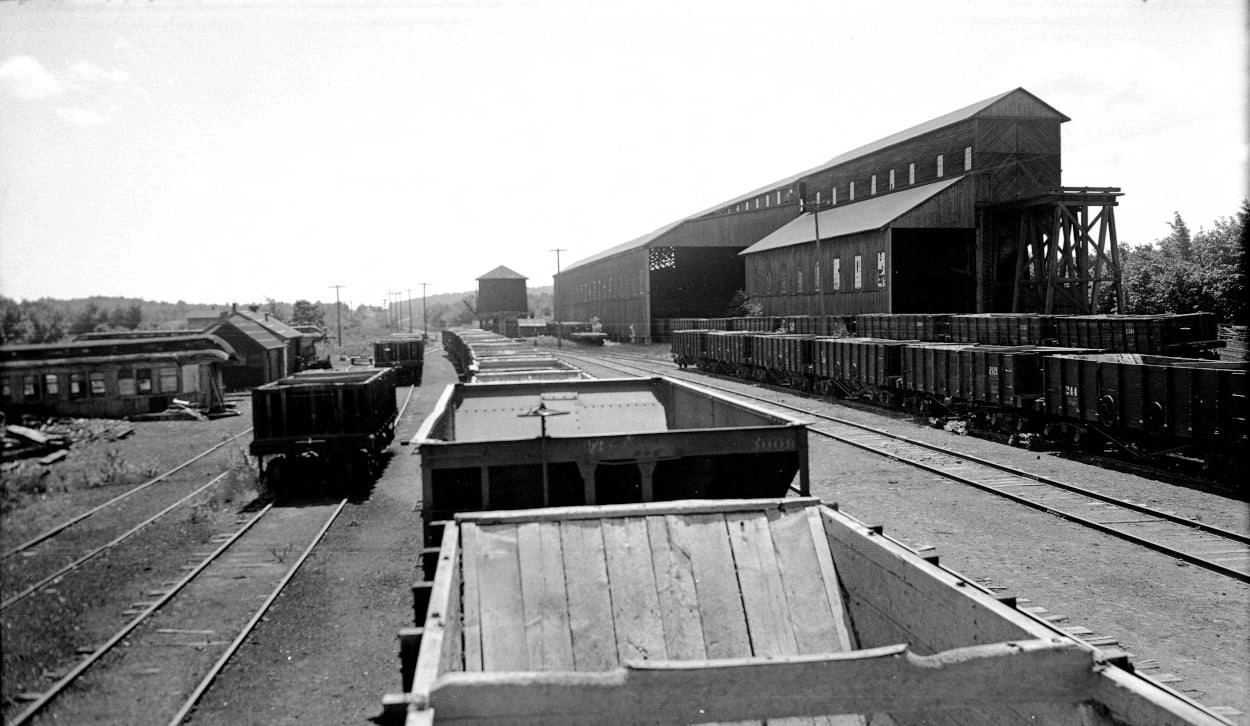- Details
- Hits: 3403
Crossing: Mill Mine Junction, MI

Depot.webp)

 Mill Mine Junction was a later name for Painesdale Junction. When the Copper Range railroad built north from Mass City to Houghton in 1893, this was a crossing of main line and its branch lines to Painesdale (to the south) and the Redridge/Freda mills to the west. Later, the Painesdale branch became the new main line, when the branch was extended to the COPR main line at Ricedale (to the south).
Mill Mine Junction was a later name for Painesdale Junction. When the Copper Range railroad built north from Mass City to Houghton in 1893, this was a crossing of main line and its branch lines to Painesdale (to the south) and the Redridge/Freda mills to the west. Later, the Painesdale branch became the new main line, when the branch was extended to the COPR main line at Ricedale (to the south).
Photo Info: Top, an early photo of Mill Mine Jct. showing the interlocking tower and depot. [CopperRange.org]. 2nd photo, the Copper Range depot at Painesdale Junction, also known as Mill Mine Junction. 3rd photo, the water tower and large coal shed at Mill Mine Jct. This was a major coal storage and distribution facility for Copper Range company mines, mills and railroad. [R.S. Platt photo]. 4th photo, an overhead view of Mill Mine Junction around 1938. The Junction depot was between the east-west main line and the southeast leg of the wye. (Note, the old main line heading south (actually west here) had been abandoned at this time. The COPR coal sheds are along the line north (west) to Freda. [USGS]
Notes
The depot here was built in 1900 and received major repairs in 1912. It was two stories, 20' x 54'. There were also two car repair houses (12'x30' and 18'x24'), two tool houses, a shovel shed and a huge wood 10,000 ton coaling station (built in 1908).
Time Line
1901. The Copper Range railroad installs a 16' x 24' water tank here. A second, similar tank is added in 1905.
1904. January 27. In coupling on to an empty passenger coach this morning at Mill Mine junction, six miles above Houghton, a coach began rolling down grade and rushed down through town, across the Portage Lake bridge and finally ending up opposite the Quincy "smelts" (smelter) without damage. The interlocking devices on the bridge paid for the expense of installation by preventing a collision with a Mineral Range train. [DFP-1904-0128]
1904. February 7. Two Copper Range trains collided near Mill Mine Junction Sunday evening, causing the breaking loose of the snow plows of both engines but no further damage. [LAS-1904-0213]
1909. A new coal shed has been constructed at Mill Mine Junction with a capacity of 15,000 tons of coal. [MCR-1909]
1911. March 1. The Copper Range railroad yesterday began for the first time to take coal from the 15,000 ton supply at Mill Mine Jct., though that coal has been on hand at that point for more than two years. The Atlantic Mine is to receive 1,500 tons and the Lake Mine 1,000 tons. This coal supply was deposited at Mill Mine as a guard against a shortage and up to this date has not been disturbed, all consumers being supplied from the Copper Range dock at Houghton, where the supply held out until now. [CN-1911-0301]
1913. October. J.C. Lowney of Butte, Montana is the only national officer of the Western Federation (of Miners) now in the district. He visited the Copper Range railroad mill mine at Junction Station to meet a train, which was thought to carry strikebreakers, but the train had no imported men aboard. Later there was considerable shooting in the business portion of the village of South Range. Militia restored order. [LSJ-1913-1027]
1913. November 19. Telephone wires cut by strikers. The wires of the Copper Range railroad and the Western Union telegraph wires were cut at Ricedale and between Mill Mine Junction and South Range. In consequence, train service was delayed several hours. [DFP-1913-1119]
1917. February 9. Carl Harju was buried in a pocket containing soft coal at Mill Mine Junction for more than an hour and was discovered when a locomotive stopped for fuel and he was shot into the tender of the engine. He was unconscious when found but doctors say he will recover. Harju was buried by the coal when at work dumping coal cars into the pocket. [DET-1917-0224][PHTH-1917-0209]
1933. The railroad had a line-side telephone for crews to use in the Mill Mine waiting room.
1950's. The coal shed and water towers were torn out here. [MIS-2024-1]
Bibliography
The following sources are utilized in this website. [SOURCE-YEAR-MMDD-PG]:
- [AAB| = All Aboard!, by Willis Dunbar, Eerdmans Publishing, Grand Rapids ©1969.
- [AAN] = Alpena Argus newspaper.
- [AARQJ] = American Association of Railroads Quiz Jr. pamphlet. © 1956
- [AATHA] = Ann Arbor Railroad Technical and Historical Association newsletter "The Double A"
- [AB] = Information provided at Michigan History Conference from Andrew Bailey, Port Huron, MI

